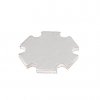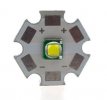I'm not convinced about that, the heatsink should spread out the hotspot caused by the chip so that the centre of the hotspot stays a few degrees cooler even though there is the same amount of heat coming out. The case itself seems to be made of plastic that is thermally conductive which is why it feels hot at only 45 degrees C so there is a decent temperature gradient even without active fans..
Trust me on this one - I've sat with the ME's doing the thermal simulations. At constant use sort of scenarios (time on the order of hours, not minutes), heat sinking or even spreading, with no forced heat extraction (convective cooling by air moving over the sink, negligible in small housings w/ no fans) does almost nothing for peak temperatures on-die (by which I mean single transistor-junction type temps, not the BGA package surface). It only affects the time slope to when the constant maximum temperature point is reached. The critical factors are the base temp (in this case, ambient temp of the case) and thermal resistivity bottlenecks from the die all the way out.
But all this is beside the point if the thermal issue wasn't the driver for the resets...all it will accomplish is a little better chip lifetime due to reduced thermal stress gradients (statistically).
Those thermoelectric chillers generate a lot of extra heat!
...In a drinks cooler you are only removing whatever heat is leaking back in so with good insulation you don't need much power but for a processor it's a different story.
Well, they're not 100% efficient, so yes, it will take more than "10W" to remove "10W" worth of heat, but the point is positioning. A small Peltier tile cemented with good thermal paste to the top of a chip package can 'cool' the BGA surface to even below ambient temps (e.g. below the 'base' temp environment), which would permit lower junction temps. All that comes in exchange for more heat on the hot side of the thermoelectric gradient, and more demand on the source(thus a bit more heat in voltage regulator chips, etc). All active cooling systems - thermoelectric, fans on heat sink/spreaders, forced liquid cooling, etc. - are net-heat inefficient (the TE effect, pumps, fans motors, all need power). But they selectively decrease temps, locally, in exchange for more heat generated overall. If chip temps are part of what is influencing video processing speed, that might be a valid trade. Plus you could 'cool' the chip down from a super high non-functional ambient (sitting in a closed car) quicker than your A/C will reach the bits that matter thru the case.
There are even thermoelectric based wine coolers now vs. compressor units...said to be preferred because they don't vibrate the wine sediments up ;-) . So yes, TE is for actual refrigeration, not just 'slowing down heat moving into the system' as you described.
Do people here mostly remove their cams from their mounts during the day, those of you who are in hot climates? I thought that was mostly for theft prevention. Admittedly, I wouldn't leave my cellphone in my hot car and expect it to work w/out cooling off (although the car stereo, nav video system, backup camera, etc. all do just fine) so I may have to rethink because of the battery and the right-on-the-windshield exposure. I don't expect it to work in the hot car with the engine off (already read that the G-shock feature of the 0803 should be assumed to not work before I committed to buy, and I don't have a constant-power harness planned).



